Description
Redpipe CAMELOT
Electronic bagpipe with the appearance of a real medieval bagpipe!
Leather bag with show drones and blowpipe made of wood
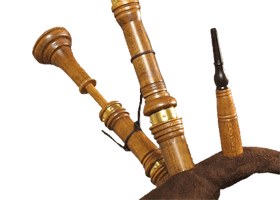
The redpipe camelot belongs to the model line of air blown bagpipes. Via the blowpipe the bag is inflated like an acoustic pipe. A valve is used to adjust the air consumption of the redpipe. During the game, a certain amount of air can escape from the bag, so that a realistic game feeling occurs. The player can decide for himself/herself how much air he/she wants to blow by adjusting the air consumption.
The drones and chanter, as well as the overblowing, are pneumatically controlled by pressure on the bag. How hard you have to press is adjustable. Playing is possible even with little pressure.
Fingerings
Up to 7 fingering tables are available. These can be combined with all sounds.
– Medieval (market) bagpipe (open bagpipe fingering)
– Shepherd’s pipe / French cornemuse (semi-closed fingering with second thumbhole)
(
audio sample 1
/
sound sample 2
)
– Hümmelchen & Dudey (baroque recorder fingering)
(
Audio sample 3
/
sound sample 4
)
– Scottish Highland Bagpipes & Smallpipes
with 3 variations of the Scottish bagpipe fingering:
– Minimal: open and without vibrato
– Default: GHB half open and vibrato are activated
– Extended: semitones are playable, extended range, vibrato and overblowing
(
Audio sample GHB
/
sound sample Smallpipe
)
– Gaita Gallega (with standard and extended fingering)
Optional extensions:
– French chanter (with 2nd thumbhole) with the semi-closed French and the baroque Hümmelchen fingerings
– additional dragon head above the chanter
– Preset Storage for saving up to 10 presets
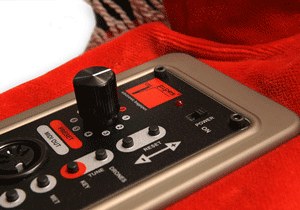
Very useful extension, with which up to 10 settings (fingering, sound, pitch, etc.) can be freely stored.
Sounds
The 4 sounds present in the instrument are sampled from original instruments. The sounds controlled by microprocessors are changed depending on the key setting. The sounds can be freely combined with the fingerings:
– Highland Bagpipe
– Shepherd pipe / medieval bagpipe
– Hümmelchen / Highland Smallpipe
– Gaita Gallega
Real Bagpipe Sound
With an acoustic pipe, the pitch is slightly lower at the start until the right pressure is in the bag, which means the pitch varies slightly at start and stop. This function is also a characteristic feature of the redpipe.
Key
The key can be changed in wide ranges in semitone steps.
Pitch
The redpipe is set to A 440 Hz in the factory setting. When playing with instruments that have a different tuning, the redpipe can be easily adjusted. The tuning is global and independent of the fingering. So you can change keys and the overall tuning remains the same.
Intonation
Drone instruments as well as bagpipes are normally tuned pure. In the studio as well as when playing together with other tempered instruments, problems can occur. Change from pure tuning to equal temperament without any problems!
Basic tuning
The basictuning is switched with the fingering table:
– GHB: keynote b flat
– French cornemuse / shepherd’s pipe: fundamental G
– Hümmelchen and Dudey: keynote C
– Gaita Gallega: keynote C
Drone tuning to the keynote
– Root / Octave drone (default setting): The drone is the root of the chanter plus the octave.
(Example: Lowest note is C – drones in C for C major).
– Fourth bordun: It sounds the fourth to the keynote of the chanter
(Example: root note is C – drones in F for key of F major).
– Second bordun: It sounds the second to the keynote of the chanter
(Example: root is C – drones in D for key D minor or dorian)
Drone finetuning
The drones can be finely tuned in their pitch in relation to the chanter. The volume of the drones is adjustable.
Overblowing
All redpipes have a range of 1 1/2 octaves. To overblow, either open the upper thumbhole or press harder on the bag.
Vibrato
Realistic playing of vibratos like acoustic bagpipes!
Modes
The mode of a Scottish bagpipe is set to Mixolydian. As a result, many non-Celtic tunes are missing two notes. With the redpipe you can choose between the following two modes:
– Mixolydian
is one of the four old authentic modes or church keys. In this scale, a semitone lies between the third and fourth as well as the sixth and seventh degree, the other intervals are whole tone steps. The minor seventh is characteristic, all other notes correspond to those of the major scale.
– Ionic
is one of the authentic modes or church keys added by Glarean in the 16th century. From it emerged our present-day tonal gender, the major. In this scale, a semitone lies between the third and fourth and the seventh and eighth steps; the other intervals are whole-note steps. The major third is characteristic.
Metronome
is integrated and freely selectable in tempo. The beat of the metronome is signaled by a click in the sound as well as by the LED.
Outputs
– Line out
– Line level not adjustable 6.35mm jack socket for external audio system or radio transmitter
– Headphones: For normal stereo headphones or earphones – volume adjustable – 2.5mm jack socket. Also suitable for monitoring on stage.
MIDI
At the 5 pol. DIN socket MIDI OUT a normal MIDI cable is plugged in. With it you can control all tone generators with MIDI input, sequencers or other MIDI devices (e.g. also personal computers equipped with sound card and MIDI interface).
The redpipe uses MIDI channel 1 for the chanter data and on channel 2 to 4 for the drones.
Technical data of the redpipe:
– Power supply: 2 AA alkaline batteries (included).
– Battery life: approx. 20 hours with alkaline batteries (depending on the connected devices)
– Weight: 1.3 kg
(To play with the redpipe you need standard earphones (stereo) or you have to connect the instrument to an amplifier).
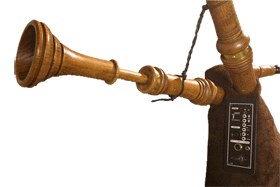
And that’s how easy it is to play on the redpipe:
– Plug in headphones or connect the pipe to an amplifier with cable or radio transmitter.
– Switching on at the slide switch
– Selection of the desired fingering. When switching, the instrument is immediately set to the usual basic tuning (e.g. with the half-closed fingering of the shepherd’s pipe, the starting key is ‘G’)
– Choose sound: Highland Bagpipe, Shepherd’s Pipe / Medieval Market Bag, Gaita Gallega or Hümmelchen / Smallpipe.
– Select key / pitch: Either in semitone steps (1/2 tone higher or lower per button press), or steplessly if you need to adapt to instruments tuned to specific frequencies.
– Set drone accompaniment tones: alternatively fundamental or as a fourth or fifth drone. The drones can be regulated in volume. Even fine(-)tuning the pitch of the drones in relation to the chanter is possible!
– Adjust the volume of the instrument – the drones can be set louder or softer separately from the chanter.
– Starting the pipe: inflate and put pressure on the bag and off you go!



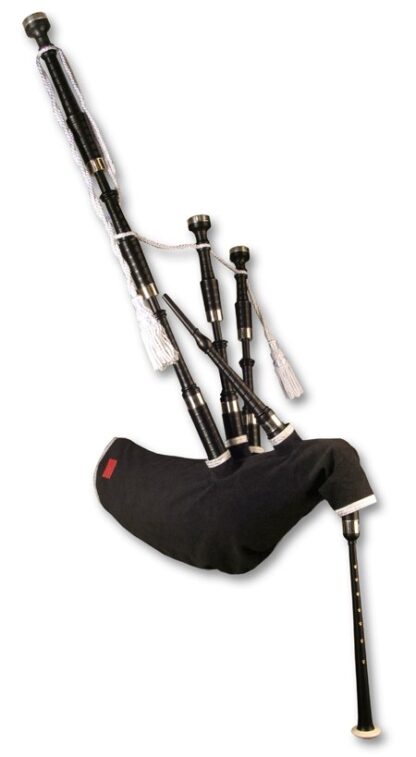
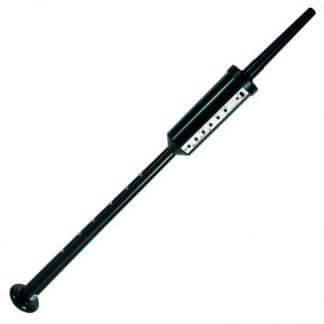
Reviews
There are no reviews yet.